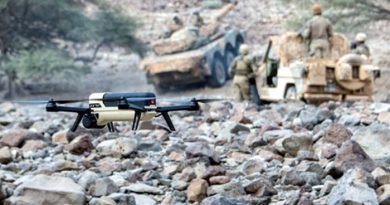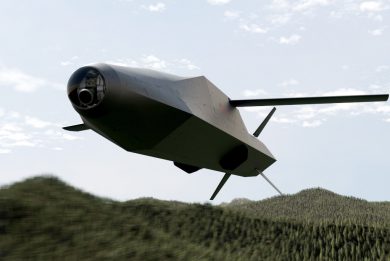IMDEX 2025 – HTK, MBDA’s new UAV interceptor for the neutralising micro and mini-UAVs’
At IMDEX in Singapore, among a range of products, a small interceptor drone from MBDA caught our eye: the HTK (Hit To Kill), a small interceptor drone developed by MBDA in partnership with French SME Novadem. It is part of MBDA’s Sky Warden modular C-UAS solution, designed to neutralise the growing threats posed by micro and mini-UAVs in modern theatres of operations
The HTK has a central vertical fuselage that contains batteries and electronics, to which a tubular structure is attached, which spars that maintain the drone in the launch container, avoiding the propeller/rotors to hit the inside surface of the launch system. Eight motors activate the same number of propeller/rotors that ensure the HTK to reach a considerable speed, a must for an interceptor which action is based only on kinetic energy. This direct-impact (kinetic) interceptor drone weighs between 1 and 2 kg and has a maximum speed of 200 km/h. Its interception range is up to 5 km according to MBDA, although the first versions are optimised for engagements at around 2 km (with the aim of adding 2 to 3 km depending on developments).
Its mode of action is to neutralise by direct collision with the target; therefore no explosive charge is hosted on board, thereby limiting the risk of collateral damage. Its on-board designation module is capable of calculating and adapting the trajectory in real time, supported by a data link for dynamic target tracking. It carries a small on-board sensor for acquisition and final locking onto the target before impact. It is launched vertically, and several UAVs can be stacked in a launcher tube. Finally, the HTK is controlled via a ground station with a touch-sensitive tablet, which can be integrated into a superior command system.
The HTK is designed to intercept and destroy micro and mini-UAVs (Class 1 and small Class 2). It is used to protect sensitive sites, convoys or deployed units, in conjunction with other effectors (jammers, lasers, missiles). It can be integrated into a complete anti-drone warfare chain, from detection to neutralisation, via the Sky Warden system, and can operate in a stand-alone environment or be integrated into a multi-layered air defence architecture.
The HTK’s strengths are that it greatly reduces the risk of collateral damage, making it ideal for operations in urban or sensitive areas; its high speed and dynamic guidance allows it to intercept fast, manoeuvrable targets; it is part of a multi-sensor, multi-effector architecture that can be adapted to suit the threat and the operational context; and it is easy to deploy thanks to its vertical launch and the possibility of carrying it on various vehicles or fixed platforms.
Photos by J. Roukoz





